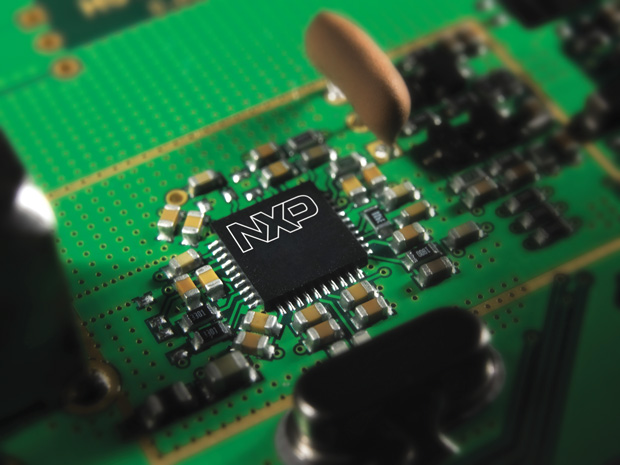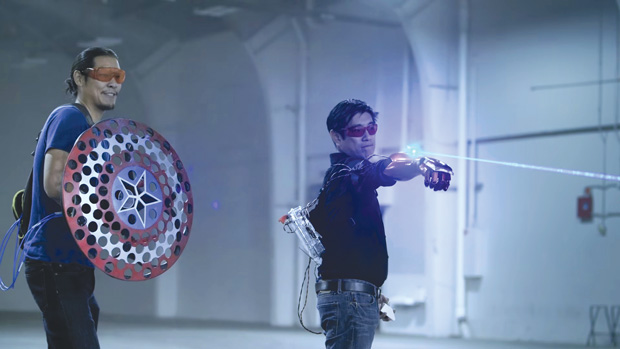
NXP chip on board: Semiconductor maker NXP and other sensor makers can expect IoT to drive growth. Image courtesy of NXP.
Latest News
August 1, 2016
Iron Man’s laser-shooting glove, Captain America’s flying shield—can such imaginary superhero devices be created using today’s technology? That’s the challenge taken up by the web TV show “Project Heroes.”
Standing 5’ 7” in his trademark long-sleeved black shirt, Grant Imahara, the host of “Project Heroes,” looks more like a startup executive than a superhero. In fact, any hardware startup would be lucky to have him in a leading role. Imahara’s TV and film career includes roles on “Mythbusters” and “Battlebots,” He’s also the inventor behind well-known robotics, such as the Star Wars prequel-era R2-D2. In the first two episodes, Imahara and his cohost Allen Pan showed step by step how to use the electrical components available in the market to duplicate technology imagined by Marvel Comics writers.
Factory for the Superheroes
Without access to Tony Stark’s research lab, Imahara built the laser-shooting glove with 3D-printed components and the highest powered laser he could legally buy. Pan couldn’t get the mythical Vibranium Steel alloy to mold Captain America’s shield, so he built a replica using aerodynamic foam pieces. A potentiometer and accelerometer made it possible for Pan to control the shield’s flight using hand gestures. Imahara and Pan’s sponsor is Mouser Electronics (not Stark Industries). They used components from Molex, Analog Devices, Cypress, Kemet and other participating electronics suppliers.
 “Project Heroes” cohosts Allen Pan (left) and Grant Imahara (right) face off against each other with their own versions of Captain America’s shield and Iron Man’s glove. Image courtesy of Mouser Electronics.
“Project Heroes” cohosts Allen Pan (left) and Grant Imahara (right) face off against each other with their own versions of Captain America’s shield and Iron Man’s glove. Image courtesy of Mouser Electronics.Entertainment value aside, Project Heroes offers insights into the unsung heroes of modern gadgets—the microcontrollers, microprocessors and sensors that have long since supplanted the clumsy mechanical apparatuses. At the recent Sensors Expo (June 22-23, San Jose, CA), Mouser and other sensor makers showcased their accelerometers, gyroscopes, magnetometers and other components. The talk on the show floor was mainly about IoT (Internet of Things) risks and opportunities.
IoT by the Numbers
Christopher Rommel, executive VP of IoT and Embedded Technology for the analyst firm VDC Research, presented findings from the 2016 IoT Survey, conducted on behalf of Sensors Expo. Forty-one percent of the survey participants state they’re consolidating sensor functionality into more intelligent/centralized hubs. Thirty percent revealed they are integrating more sensors of different types in their current projects. Thirty-six percent indicated they intend to integrate more sensors of different types in the next three years. Rommel and his colleagues believe “predictive maintenance will drive need for traditional sensor types,” and “new use cases will drive need for machine vision solutions.”
When ranking IoT market inhibitors, participants put security challenges and concerns at the top, followed by end-customer demand and readiness, lack of common standards, and maturity of available commercial products. “By and large, businesses don’t delay or postpone IoT projects due to security concerns,” Rommel said. One reason may be the cost of the fix. “If the fix is at a component level, the cost may be too prohibitive,” he added. Another is time-to-market and competitive pressure. “People are always fighting to meet deadlines; they’re already late. They also know their competition is rapidly making progress,” he said.
Enter AI and Machine Learning
Semiconductor maker NXP equipped a double-decker trailer with its technology to demonstrate how it can power smart homes, smart appliances, gyroscopes and 3D printing. Telit promoted its IoT factory solutions, powered by its deviceWISE platform. Developed to operate within an enterprise’s premise, deviseWISE “connects and integrates production machines and processes with existing enterprise resource planning (ERP) and manufacturing resource planning (MRP) systems and supervisory control and data acquisition (SCADA) applications,” the company says.
China-based INMOTION SCV (sensor-controlled vehicles) is known for Segway-like unicycles and personal mopeds. At the expo, it promoted its 3D depth camera line as “high performance robot navigation and positioning solutions.”
 NXP chip on board: Semiconductor maker NXP and other sensor makers can expect IoT to drive growth. Image courtesy of NXP.
NXP chip on board: Semiconductor maker NXP and other sensor makers can expect IoT to drive growth. Image courtesy of NXP.VDC Research’s Rommel said: “[IoT] fundamentally changes how you go about monetizing your product, how you derive value.” One way IoT changes the connected device industry is to shift the emphasis from the device to the data. Gadget makers are quickly coming to the realization that a connected device that merely collects, transmits and receives data adds very little value. Only a device that adapts and anticipates—for example, a heartrate monitor that recognizes symptoms of pending cardiac issues and can send warnings, or a home thermostat that can sense when the occupants are absent and turn itself off—may truly be considered IoT-enabled. Such AI-like intelligence can only come from data—lots of data.
Therefore, data analytics and machine learning solutions are expected to become an integral part of the sensor-driven future.
One real-world example comes from Horse Sense Shoes, which uses NXP’s accelerometers, magnetometers and air pressure sensors to look for deviations from a horse’s normal routines—signs of deteriorating health in the animal. “If the horse is usually laying down for two hours a day, and now, all of a sudden, it’s laying down four hours, that’s a flag, so [the app] sends a text message to the owner or the vet,” said Roger Roisen, CTO of Horse Sense Shoes, in a TV interview with NWCT.
One of the exhibitors at Sensors Expo was RealityAnalytics, which claims its software “[uses] advanced, patented artificial intelligence techniques to detect real-world events in sensor and signal data so apps and devices can take action.” It currently offers two products: Reality AI for IoT and Reality AI for UAV.
Episode 3 of “Project Heroes” brought the faceoff between Imahara’s version of the Iron Man glove and Pan’s version of the Captain America shield. Most people saw a sleek, shiny glove that shoots laser beams hot enough to melt its target; and a shield that flies through the air, slices off the target and returns to its owner. Only engineers see the true source of these technical marvels—the sensors, microprocessors and electrical components under the hood.
More Info
Subscribe to our FREE magazine, FREE email newsletters or both!
Latest News
About the Author
Kenneth Wong is Digital Engineering’s resident blogger and senior editor. Email him at kennethwong@digitaleng.news or share your thoughts on this article at digitaleng.news/facebook.
Follow DE





